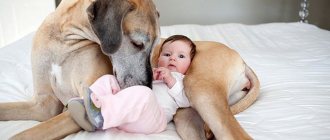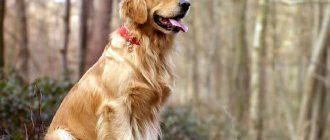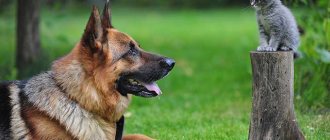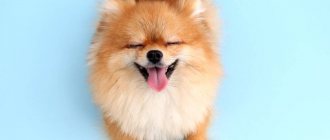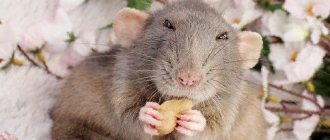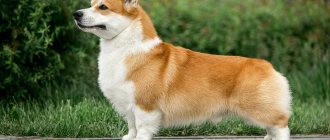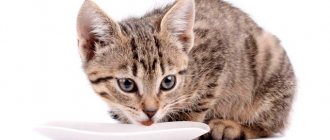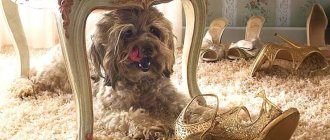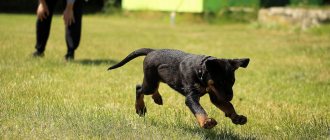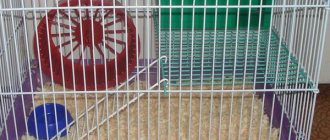Food and bowls
The puppy's food should be recommended by the breeder. After moving, you should not suddenly change your usual food, as this will cause additional stress for your pet. You can change the food after the puppy adapts to the new place. We recommend biologically appropriate nutrition. It’s good if the breeder has already accustomed the pet to healthy food. If not, we recommend trying SUPERPET: it's great for puppies.
Bowls come in different sizes and from different materials. It is advisable that the bowl is approximately twice the size of the serving of food. If your pet eats 150g, the bowl should hold 250-300g of food. Then the food will not fall on the floor due to the fact that the bowl is filled to the brim, and the dog will be able to eat comfortably. The material can be any, but for convenience you can buy bowls with a rubberized bottom. Then the bowl will not slip while eating.
Treats are useful for training or just to pamper your pet. We recommend natural treats: they do not contain artificial ingredients and are easily digestible.
Before the puppy arrives
You need to prepare thoroughly. First, remove from the “reach zone” all objects that can be chewed or dragged in the mouth. A puppy can be interested in absolutely everything that can be reached with its paw or teeth. Little children touch everything with their hands, but a puppy touches everything with his teeth. Wires, tees, books and disks on the floor pose a serious danger.
Chewed objects can be eaten, and then this will lead to surgical intervention! So it is better to prevent your baby from eating them. We also recommend removing decorative rugs and carpets from the floor during toilet training. It is difficult for a puppy to explain the difference between them and a diaper. Removed? Now go downstairs, squat down, and inspect everything again. Can't you eat anything from this angle? Great! This means the puppy’s home is safe! You can invite us to visit!
Everything for walking
The collar should be comfortable and made of durable material. Collars come in metal, nylon, leather and biothane. The latter are considered the best, but can be difficult to find. Experts do not recommend metal collars for permanent use. They are intended more for training; at other times it is recommended to use collars made of softer materials. The length of the collar should be such that the dog cannot remove it over the head, but so that two fingers can be placed between the collar and the neck (so that the collar does not choke the dog).
tag will be useful to make it easy to find your puppy if he gets lost. The tag should include the puppy's name and your contact information, such as a phone number. A chip can handle this task, but a tag will help identify the dog faster.
A harness can be an excellent addition to a collar during walks. Harnesses are especially useful for owners of dogs with thin necks (such as greyhounds). The puppy can always wear a collar, but it is recommended to use a harness only during walks and trips.
The leash can be nylon, rope, metal or leather. Which material to choose depends on your preferences and your puppy's behavior. If the puppy chews on the leash, the nylon and rope ones will quickly break. In this case, it is recommended to purchase a metal leash.
Leashes come in different lengths; there are roulette leashes with a lock. The latter seem convenient to many, but dog experts do not recommend them. This type of leash teaches the dog that if you pull harder, you can get further away. That is, roulette provokes potentially unwanted behavior. An alternative to a roulette leash is an adjustable leather leash.
Bags are needed if you walk your puppy in city parks.
First aid kit for dogs
It is very important to collect everything you need, because you never know where and what kind of trouble will happen. Especially often such surprises happen to puppies that are not yet adapted for a conditionally independent life.
Here is a list of medications needed in a first aid kit for a dog:
- Ear cleaning sticks;
- Cotton swabs (for treating wounds);
- Adhesive plaster - two spools 1.5 cm wide, two spools 2.5 cm wide (for paw cuts);
- Bandages (simple and elastic) 4 and 7 cm wide (for paw cuts);
- Hydrogen peroxide (5 pcs.) and hydroperite (2 packs of tablets);
- Miramistin (or other antiseptic);
- Synthomycin emulsion 5 and 10% (for bites and cuts);
- Children's medicine for diarrhea;
- Antihelminthic drug for 17 and 40 kg of live weight (usually six tablets);
- Medical tourniquet to stop bleeding and instructions in pictures (how to stop bleeding from cut paws);
- Oilcloth;
- Enema No. 1 and No. 3;
- Pipette and tweezers;
- Syringes for 2, 5 and 10 ml;
- Chamomile (herb, sold in pharmacies);
- Vaseline oil;
- Healing ointment (“Boro+”, “Rescuer”, or “Levomikol”);
- Potassium permangantsovka;
- Activated carbon;
- Tavegil or suprastin ;
- Sangel , used to treat external wounds
In addition to everything, you must have the veterinarian’s phone number and veterinary passport - it should always be at hand.
Toys
To prevent the puppy from damaging furniture and chewing shoes, it must have entertainment. Games help to waste energy, stimulate brain activity and not get bored when the owner is at work. Different toys serve different functions, so it's great to give your puppy a choice.
Chew toys are especially useful during teething periods. Adult dogs are also not averse to chewing - this is how they train their jaws and clean their teeth. For these purposes, you can give natural treats, for example, SUPERPET deer treats. But the number of treats your pet consumes per day should not exceed 10% of the daily requirement. For example, if your dog's daily intake is 500 kcal, then you should not give more than 50 kcal worth of treats per day. Chew toys are a great addition to treats.
Toys for active games can be taken for a walk or used at home. Such toys include everything that a puppy can run after: balls, rubber toys, rings, flying saucers for dogs, etc.
Distracting toys will keep your puppy occupied for a while and help stimulate his brain. Usually these are toys in which treats are hidden - puzzles, balls with a hole, kongs, etc. These toys are good to leave for your puppy while you are away from home.
The puppy can carry soft toys These toys can help your dog relieve stress, especially if you take the stuffed toy with you on a trip or to the vet. Soft toys absorb the smell of home and the puppy itself. A familiar smell calms you down in a stressful situation.
Useful video
We found a video for you from a professional dog lover who knows exactly what a puppy might need:
Of course, each puppy is individual and any conscientious owner wants to give him everything he needs. And the pet will definitely respond for this care with his love and devotion, because it’s not for nothing that they say that there is no better psychotherapist than a puppy licking your face.
How do your pets show their love? Perhaps they are trying to lick you while jumping, or are they starting to spin around like clockwork? Leave comments, because everyone who keeps a dog at home has an interesting story or a funny photo with their pet.
Care products
The comb is especially useful for owners of long-haired pets for grooming. Combs come in different sizes, shapes, and have different bristles. Different combs are designed for different types and lengths of hair. A groomer or consultant at a pet store will help you choose the best comb for your pet.
Shampoo will be useful to wash the puppy after a walk if he is very dirty. Dogs cannot be washed with human soap, so you need to have a special dog shampoo at home.
Nail clippers will help you care for your puppy's paws. Before trimming your puppy's nails, be sure to learn how to do it correctly and painlessly.
A toothbrush will come in handy if you plan to teach your puppy to brush his teeth.
Vet Tips: Pet Accessories
What veterinarians primarily advise is to monitor the quality of things that are purchased for the dog. At best, bad items and accessories will simply quickly become unusable. However, often low-quality toys, collars or leashes led to the pet’s physical condition suffering.
The article talks about everything that dog owners may need. Most items can be purchased in advance; the main thing is to know which breed will soon appear in your house or apartment.
Toiletries
Diapers will be useful while you are teaching your puppy to use the toilet outside. While the puppy is learning, embarrassments may occur. In order to minimize them, use special diapers.
The hygiene product will be relevant while the puppy is learning to go to the toilet outside. Sometimes your puppy can't wait to go for a walk, so it's helpful to have a product to help with cleaning. We recommend using products without a strong odor.
Tray
How to find out the breed of a dog by the appearance of the puppy
A necessary item for both the pet and the owner, as it makes cleaning much easier. Most often, a tray with absorbent filling is chosen. This is a convenient option that can be purchased at any store. But it is worth mentioning that the filler should be natural, since a small puppy can easily swallow the contents of the tray.
A tray with a diaper is even more convenient, since the owner can teach the dog to wear a diaper quickly enough. And, for example, somewhere at a party a dog can relieve itself in a diaper, which is much more convenient than carrying a tray with you or hoping that another house has one. Diapers are convenient to use when transporting, flying on an airplane or traveling by train.
What else?
Bed . The puppy must have its own sleeping place. The bed must be the right size. You can buy a smaller one first, and then replace it with a larger one when the puppy grows up.
A carrier is especially useful if you decide to adopt a small breed dog. The carrier is convenient for transporting a puppy from the breeder. It can also be useful for traveling and trips to the veterinarian.
a cage , but it can be a useful purchase. Your dog will have a safe place to relax and deal with stress. By crate training your dog, you will reduce stress from travel (for example, if you decide to fly with your dog on an airplane), from visits to the veterinarian (if the dog is undergoing surgery, he is often crated afterward to recover), and when you are not home. Of course, the cage should be spacious enough, and the dog should be comfortable in it.
Before your pet arrives, evaluate how safe the home is for him. Hide wires and cables. To be on the safe side, remove anything that your puppy might chew on, such as shoes and children's toys.
Treats
What a dog needs in an apartment: the list must include special treats. With their help, you can not only please your dog, but also reward him for good behavior. Special snacks are also used as an element of training.
You can use a variety of options, depending on your pet’s preferences. These can be crackers, cookies, bones, meat sticks and so on. It all depends on the taste preferences of the pet itself.
Important! You need to choose only specialized products. Most things from the human diet are contraindicated for animals. This especially applies to sweet, flour, smoked and salty foods.
GO BETTER WITH CHILDREN
If there are children in the house, then it is not advisable to have guard, fighting, hunting or service dogs. In this case, you will have to engage in thorough field preparation, training and training of the dog according to a strict schedule with the involvement of specialists in this field.
In order for a dog to get along with children, you need to study the character and activity of the breed, and also take into account the age, character of the children and their attitude towards dogs. For friendly communication, relaxation and family walks with children, dogs of medium breeds are suitable: Labrador, Golden Retriever, Husky, Dalmatian, as well as representatives of such small breeds as Beagle, Welsh Corgi, French Bulldog.
Transport accessories
Often there is a need to transport a puppy in your own car or on public transport, including to a veterinary clinic. For such moments, it is necessary to purchase specialized tools. These include, in particular, the container - it must match the size of the puppy and not be too tight. For large animals, a harness or seat belt is useful, reliably securing the animal in its place in the car.
Hurry up, choose a box and find out what gift awaits you
Discount on pet insurance
Promo code copied to clipboard
